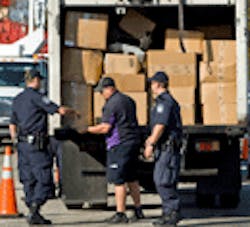UMTRI says CSA passes test
The University of Michigan Transportation Research Institute (UMTRI) said that a Compliance, Safety, Accountability testing model used by the Federal Motor Carrier Safety Administration (FMCSA) “substantially improves” enforcement and compliance with federal safety regulations.
UMTRI’s study, released by FMCSA, reviewed the agency’s Operational Model Test (Op-Model Test), which was used to determine the effectiveness of CSA. While UMTRI said that the test model led to improved enforcement, it did note areas in need of further improvement , especially regarding the Cargo-Related and Driver Fitness BASICs.
The agency said the results show the CSA model enables FMCSA and its state partners to contact more commercial motor carriers earlier to correct safety problems and ensure compliance with safety regulations to reduce crashes, injuries, and fatalities related to commercial motor vehicles.
Launched in 2008, the CSA Op-Model Test divided motor carriers from four test states (Colorado, Georgia, Missouri, and New Jersey) between test and control groups. UMTRI evaluated the effectiveness of the new Safety Measurement System (SMS) and CSA interventions, and compared the cost and efficiency of the CSA compliance and enforcement model to the previous model.
FMCSA stated they found effectiveness and efficiency gains that fully support the ongoing national implementation of CSA. The agency added the states of Delaware, Kansas, Maryland, Minnesota and Montana to the test “to demonstrate full implementation challenges and to provide a validation dataset for evaluation purposes.”
Per FMCSA, key findings by UMTRI include:
- “The results showed that the SMS is a significant improvement over the SafeStat system in identifying unsafe carriers. “
- Crash rates were higher for motor carriers identified with safety problems in the SMS’s seven Behavior Analysis and Safety Improvement Categories (BASICs) than for motor carriers that were not identified with safety problems in the seven BASICs
- The crash rate for motor carriers that were identified with safety problems by the SMS in the Unsafe Driving BASIC was more than three times greater than the crash rate for motor carriers not identified with any safety problems by SMS.
- “The effect of the warning letter intervention is likely one of the most significant findings in this evaluation. ” Twelve months after receiving a warning letter, SMS results showed that 83% of test carriers had resolved identified safety problems and only 17% continued to have safety problems.
- The new CSA onsite focused investigations proved to be effective. Almost 20% fewer motor carriers continued to show safety problems 12 months after an onsite focused investigation, as compared with those receiving traditional compliance reviews (CRs).
- More intensive interventions were used on carriers that exhibited higher crash risk confirming that the rules guiding intervention selection are operating to ensure effective and efficient safety interventions.
- Warning letters, which were found to be very effective in improving safety behavior, had only a nominal cost.
- CSA onsite focused investigations cost approximately 53% less than CRs and were effective in producing compliance.
- The average cost of CSA interventions was $754 per motor carrier, as compared to $1,438 for motor carriers receiving CRs.
- CSA interventions contact approximately three times the number of motor carriers contacted using the previous model which relied primarily on CRs.
- Among the CSA test group, the annual percentage of motor carriers contacted was 9.9%, compared with 3.2% of motor carriers that received full CRs in 2009.
UMTRI identified some areas that require improvement and FMCSA said it is “firmly committed to a continuous improvement process for this very important program.” SMS’s BASICs are significantly related to underlying motor carrier safety, although the Cargo-Related and Driver Fitness BASICs show a weaker relationship to crash risk.
The agency also said UMTRI’s findings are in line with FMCSA’s effectiveness findings; as a result, at the end of the Op-Model Test, FMCSA adjusted how it identifies motor carriers for intervention to ensure BASICs with the strongest relationship to future crashes receive the most emphasis.
However, FMCSA said it continues to address motor carriers with patterns of noncompliance in the Cargo-Related and Driver Fitness BASICs, which include carrier requirements for being properly licensed, carrying medical cards to allow verification that a driver meets the medical qualification standards, adequately securing cargo, and properly packaging and handling hazardous materials.
As part of its “ongoing commitment to continually assess and improve the SMS,” FMCSA noted it has a study underway that may result in improvements to some BASICs, particularly the Cargo-Related BASIC.
There was lag time in measureable safety performance improvement after CSA investigations, and for carriers with the most serious safety problems, improvement rates were similar to those of the control group.
FMCSA said it “expects the upcoming Safety Fitness Determination rulemaking to accelerate return to compliance or removal from service for motor carriers with the worst safety problems.” Based on lessons learned in the Op-Model Test, FMCSA said it has improved the CSA investigative process and training in the Safety Management Cycle for its federal and state partner investigators. “The enhanced investigative process allows investigators to systematically identify motor carriers’ safety problems and to recommend remedies to help carriers to quickly become safer,” the agency noted.
